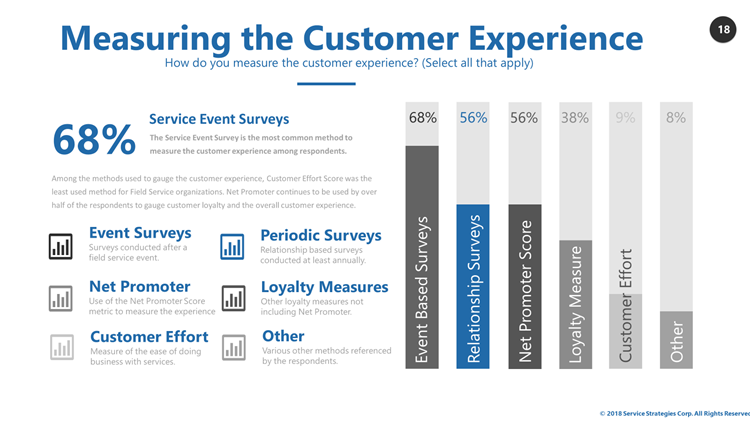Measuring The Customer Experience
By John Hamilton, President, Service Strategies Corporation

Measuring the customer experience based on the services your company provides requires that several types of survey instruments be used. It is very important to your overall business health and growth potential. Happy customers lead to more sales and more referrals. In the 2018 Field Service Practices Benchmark study conducted by Service Strategies, more than 100 technology companies identified five main survey methods used to gauge customer satisfaction and loyalty. The majority of these companies, 68 percent use an event survey, 56 percent use a periodic relationship survey, 56 percent use Net Promoter, 38 percent use a loyalty index and 9 percent use the customer effort score. In fact, most of the companies participating in the study use a combination of these survey methods.

Each of these survey instruments has a slightly different purpose. We will examine each survey type so that we can determine their value in providing specific feedback on the customer experience.
Event Survey: This survey is linked to a specific service incident/ticket and is sent to the actual user of the service soon after the issue has been closed (within 30 days). Typically, no more than 10 questions related to responsiveness, resolution and performance of the service engineer. The primary purpose of the event survey is to get timely feedback from the customers on their most recent service experience and then to use the data to drive continuous improvements. It is also important to share the survey results, including comments, with service staff and include in their performance review.
Periodic Survey: Typically, this survey is conducted annually. It has a broader set of questions to gauge the overall relationship between the company and customers. It’s purpose is to get feedback on all company interactions within the customers organization as well as to gauge satisfaction on product and service performance.
Net Promoter: Is one question “How likely are you to recommend” based on product or service experience. To derive a net promoter score, customers are grouped into “promoters” (extremely likely to recommend) “passively satisfied” and “detractors” (extremely unlikely to recommend). Then subtract the percent of detractors from the percent of promoters. The net promoter question is often combined in either the event or periodic surveys.
Loyalty Measures: Customer loyalty is most often calculated using a loyalty index using three key questions: overall satisfaction, likelihood of recommending, and likelihood of additional purchases. Only the top scores (top box) for each of these questions are used to determine the loyalty index.
Customer Effort Score: This measurement determines how easy it is to work with the service provider. The questions asked of the customer “How much effort did you personally have to put forth to handle your service request?” This is a relatively new industry measure and research has shown that of those customers who reported low effort, 94 percent expressed an intention of re-purchase and 88 percent said they would increase their spending. Only 1 percent said they would speak negatively about the company. Conversely, 81 percent of the customers who had a hard time solving their problems reported an intention to spread negative feedback.
Understanding and measuring the customer experience can be complicated. The event survey is the most widely used to get basic satisfaction feedback on service performance. The other survey instruments focus more on loyalty, retention and repeat business.
For more detailed information, you can download the entire 2018 Field Service Benchmark Study which includes field service business, operational practices and performance in the areas of:
- Service Offerings
- Field Performance Metrics
- Staff Development Practices
- Logistics
- Customer Experience Measurement
- Tools and Technology
http://servicestrategies.com/research-report-field-service-benchmark-study/
In conclusion, to fully understand the customer experience, a technique called “Customer Journey Mapping” needs to be applied. This is a more complex method of maps and models that provide a compact visualizations of an end-to-end customer experience. In essence, every touch point that your company has with the customer is analyzed and mapped. This involves more than just the service department interface and requires a total company commitment to be successful.
